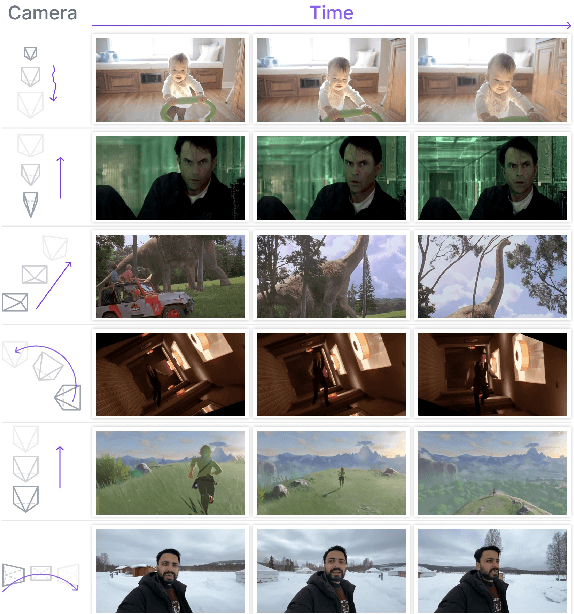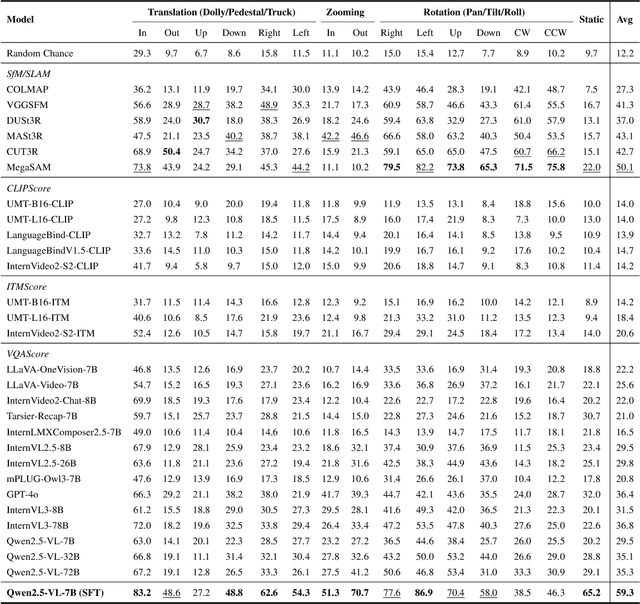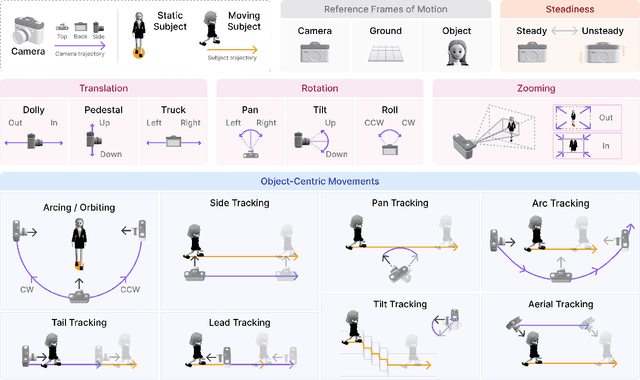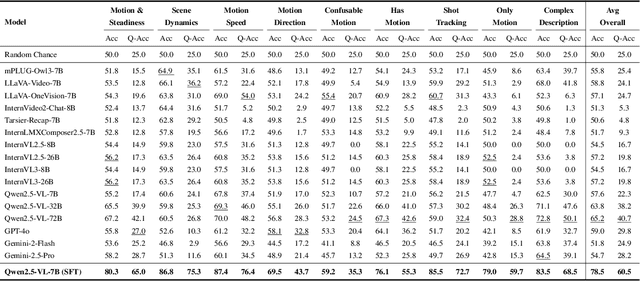Chuang Gan
TalkCuts: A Large-Scale Dataset for Multi-Shot Human Speech Video Generation
Oct 08, 2025Abstract:In this work, we present TalkCuts, a large-scale dataset designed to facilitate the study of multi-shot human speech video generation. Unlike existing datasets that focus on single-shot, static viewpoints, TalkCuts offers 164k clips totaling over 500 hours of high-quality human speech videos with diverse camera shots, including close-up, half-body, and full-body views. The dataset includes detailed textual descriptions, 2D keypoints and 3D SMPL-X motion annotations, covering over 10k identities, enabling multimodal learning and evaluation. As a first attempt to showcase the value of the dataset, we present Orator, an LLM-guided multi-modal generation framework as a simple baseline, where the language model functions as a multi-faceted director, orchestrating detailed specifications for camera transitions, speaker gesticulations, and vocal modulation. This architecture enables the synthesis of coherent long-form videos through our integrated multi-modal video generation module. Extensive experiments in both pose-guided and audio-driven settings show that training on TalkCuts significantly enhances the cinematographic coherence and visual appeal of generated multi-shot speech videos. We believe TalkCuts provides a strong foundation for future work in controllable, multi-shot speech video generation and broader multimodal learning.
Virtual Community: An Open World for Humans, Robots, and Society
Aug 20, 2025



Abstract:The rapid progress in AI and Robotics may lead to a profound societal transformation, as humans and robots begin to coexist within shared communities, introducing both opportunities and challenges. To explore this future, we present Virtual Community-an open-world platform for humans, robots, and society-built on a universal physics engine and grounded in real-world 3D scenes. With Virtual Community, we aim to study embodied social intelligence at scale: 1) How robots can intelligently cooperate or compete; 2) How humans develop social relations and build community; 3) More importantly, how intelligent robots and humans can co-exist in an open world. To support these, Virtual Community features: 1) An open-source multi-agent physics simulator that supports robots, humans, and their interactions within a society; 2) A large-scale, real-world aligned community generation pipeline, including vast outdoor space, diverse indoor scenes, and a community of grounded agents with rich characters and appearances. Leveraging Virtual Community, we propose two novel challenges. The Community Planning Challenge evaluates multi-agent reasoning and planning ability in open-world settings, such as cooperating to help agents with daily activities and efficiently connecting other agents. The Community Robot Challenge requires multiple heterogeneous robots to collaborate in solving complex open-world tasks. We evaluate various baselines on these tasks and demonstrate the challenges in both high-level open-world task planning and low-level cooperation controls. We hope that Virtual Community will unlock further study of human-robot coexistence within open-world environments.
ProsodyLM: Uncovering the Emerging Prosody Processing Capabilities in Speech Language Models
Jul 27, 2025Abstract:Speech language models refer to language models with speech processing and understanding capabilities. One key desirable capability for speech language models is the ability to capture the intricate interdependency between content and prosody. The existing mainstream paradigm of training speech language models, which converts speech into discrete tokens before feeding them into LLMs, is sub-optimal in learning prosody information -- we find that the resulting LLMs do not exhibit obvious emerging prosody processing capabilities via pre-training alone. To overcome this, we propose ProsodyLM, which introduces a simple tokenization scheme amenable to learning prosody. Each speech utterance is first transcribed into text, followed by a sequence of word-level prosody tokens. Compared with conventional speech tokenization schemes, the proposed tokenization scheme retains more complete prosody information, and is more understandable to text-based LLMs. We find that ProsodyLM can learn surprisingly diverse emerging prosody processing capabilities through pre-training alone, ranging from harnessing the prosody nuances in generated speech, such as contrastive focus, understanding emotion and stress in an utterance, to maintaining prosody consistency in long contexts.
CommVQ: Commutative Vector Quantization for KV Cache Compression
Jun 23, 2025Abstract:Large Language Models (LLMs) are increasingly used in applications requiring long context lengths, but the key-value (KV) cache often becomes a memory bottleneck on GPUs as context grows. To address this, we propose Commutative Vector Quantization (CommVQ) to significantly reduce memory usage for long-context LLM inference. We first introduce additive quantization with a lightweight encoder and codebook to compress the KV cache, which can be decoded via simple matrix multiplication. To further reduce computational costs during decoding, we design the codebook to be commutative with Rotary Position Embedding (RoPE) and train it using an Expectation-Maximization (EM) algorithm. This enables efficient integration of decoding into the self-attention mechanism. Our approach achieves high accuracy with additive quantization and low overhead via the RoPE-commutative codebook. Experiments on long-context benchmarks and GSM8K show that our method reduces FP16 KV cache size by 87.5% with 2-bit quantization, while outperforming state-of-the-art KV cache quantization methods. Notably, it enables 1-bit KV cache quantization with minimal accuracy loss, allowing a LLaMA-3.1 8B model to run with a 128K context length on a single RTX 4090 GPU. The source code is available at: https://github.com/UMass-Embodied-AGI/CommVQ.
RobotSmith: Generative Robotic Tool Design for Acquisition of Complex Manipulation Skills
Jun 17, 2025



Abstract:Endowing robots with tool design abilities is critical for enabling them to solve complex manipulation tasks that would otherwise be intractable. While recent generative frameworks can automatically synthesize task settings, such as 3D scenes and reward functions, they have not yet addressed the challenge of tool-use scenarios. Simply retrieving human-designed tools might not be ideal since many tools (e.g., a rolling pin) are difficult for robotic manipulators to handle. Furthermore, existing tool design approaches either rely on predefined templates with limited parameter tuning or apply generic 3D generation methods that are not optimized for tool creation. To address these limitations, we propose RobotSmith, an automated pipeline that leverages the implicit physical knowledge embedded in vision-language models (VLMs) alongside the more accurate physics provided by physics simulations to design and use tools for robotic manipulation. Our system (1) iteratively proposes tool designs using collaborative VLM agents, (2) generates low-level robot trajectories for tool use, and (3) jointly optimizes tool geometry and usage for task performance. We evaluate our approach across a wide range of manipulation tasks involving rigid, deformable, and fluid objects. Experiments show that our method consistently outperforms strong baselines in terms of both task success rate and overall performance. Notably, our approach achieves a 50.0\% average success rate, significantly surpassing other baselines such as 3D generation (21.4%) and tool retrieval (11.1%). Finally, we deploy our system in real-world settings, demonstrating that the generated tools and their usage plans transfer effectively to physical execution, validating the practicality and generalization capabilities of our approach.
Steering LLM Thinking with Budget Guidance
Jun 16, 2025Abstract:Recent deep-thinking large language models often reason extensively to improve performance, but such lengthy reasoning is not always desirable, as it incurs excessive inference costs with disproportionate performance gains. Controlling reasoning length without sacrificing performance is therefore important, but remains challenging, especially under tight thinking budgets. We propose budget guidance, a simple yet effective method for steering the reasoning process of LLMs toward a target budget without requiring any LLM fine-tuning. Our approach introduces a lightweight predictor that models a Gamma distribution over the remaining thinking length during next-token generation. This signal is then used to guide generation in a soft, token-level manner, ensuring that the overall reasoning trace adheres to the specified thinking budget. Budget guidance enables natural control of the thinking length, along with significant token efficiency improvements over baseline methods on challenging math benchmarks. For instance, it achieves up to a 26% accuracy gain on the MATH-500 benchmark under tight budgets compared to baseline methods, while maintaining competitive accuracy with only 63% of the thinking tokens used by the full-thinking model. Budget guidance also generalizes to broader task domains and exhibits emergent capabilities, such as estimating question difficulty. The source code is available at: https://github.com/UMass-Embodied-AGI/BudgetGuidance.
Satori-SWE: Evolutionary Test-Time Scaling for Sample-Efficient Software Engineering
May 29, 2025Abstract:Language models (LMs) perform well on standardized coding benchmarks but struggle with real-world software engineering tasks such as resolving GitHub issues in SWE-Bench, especially when model parameters are less than 100B. While smaller models are preferable in practice due to their lower computational cost, improving their performance remains challenging. Existing approaches primarily rely on supervised fine-tuning (SFT) with high-quality data, which is expensive to curate at scale. An alternative is test-time scaling: generating multiple outputs, scoring them using a verifier, and selecting the best one. Although effective, this strategy often requires excessive sampling and costly scoring, limiting its practical application. We propose Evolutionary Test-Time Scaling (EvoScale), a sample-efficient method that treats generation as an evolutionary process. By iteratively refining outputs via selection and mutation, EvoScale shifts the output distribution toward higher-scoring regions, reducing the number of samples needed to find correct solutions. To reduce the overhead from repeatedly sampling and selection, we train the model to self-evolve using reinforcement learning (RL). Rather than relying on external verifiers at inference time, the model learns to self-improve the scores of its own generations across iterations. Evaluated on SWE-Bench-Verified, EvoScale enables our 32B model, Satori-SWE-32B, to match or exceed the performance of models with over 100B parameters while using a few samples. Code, data, and models will be fully open-sourced.
Learning 3D Persistent Embodied World Models
May 05, 2025Abstract:The ability to simulate the effects of future actions on the world is a crucial ability of intelligent embodied agents, enabling agents to anticipate the effects of their actions and make plans accordingly. While a large body of existing work has explored how to construct such world models using video models, they are often myopic in nature, without any memory of a scene not captured by currently observed images, preventing agents from making consistent long-horizon plans in complex environments where many parts of the scene are partially observed. We introduce a new persistent embodied world model with an explicit memory of previously generated content, enabling much more consistent long-horizon simulation. During generation time, our video diffusion model predicts RGB-D video of the future observations of the agent. This generation is then aggregated into a persistent 3D map of the environment. By conditioning the video model on this 3D spatial map, we illustrate how this enables video world models to faithfully simulate both seen and unseen parts of the world. Finally, we illustrate the efficacy of such a world model in downstream embodied applications, enabling effective planning and policy learning.
TesserAct: Learning 4D Embodied World Models
Apr 29, 2025



Abstract:This paper presents an effective approach for learning novel 4D embodied world models, which predict the dynamic evolution of 3D scenes over time in response to an embodied agent's actions, providing both spatial and temporal consistency. We propose to learn a 4D world model by training on RGB-DN (RGB, Depth, and Normal) videos. This not only surpasses traditional 2D models by incorporating detailed shape, configuration, and temporal changes into their predictions, but also allows us to effectively learn accurate inverse dynamic models for an embodied agent. Specifically, we first extend existing robotic manipulation video datasets with depth and normal information leveraging off-the-shelf models. Next, we fine-tune a video generation model on this annotated dataset, which jointly predicts RGB-DN (RGB, Depth, and Normal) for each frame. We then present an algorithm to directly convert generated RGB, Depth, and Normal videos into a high-quality 4D scene of the world. Our method ensures temporal and spatial coherence in 4D scene predictions from embodied scenarios, enables novel view synthesis for embodied environments, and facilitates policy learning that significantly outperforms those derived from prior video-based world models.
Towards Understanding Camera Motions in Any Video
Apr 21, 2025



Abstract:We introduce CameraBench, a large-scale dataset and benchmark designed to assess and improve camera motion understanding. CameraBench consists of ~3,000 diverse internet videos, annotated by experts through a rigorous multi-stage quality control process. One of our contributions is a taxonomy of camera motion primitives, designed in collaboration with cinematographers. We find, for example, that some motions like "follow" (or tracking) require understanding scene content like moving subjects. We conduct a large-scale human study to quantify human annotation performance, revealing that domain expertise and tutorial-based training can significantly enhance accuracy. For example, a novice may confuse zoom-in (a change of intrinsics) with translating forward (a change of extrinsics), but can be trained to differentiate the two. Using CameraBench, we evaluate Structure-from-Motion (SfM) and Video-Language Models (VLMs), finding that SfM models struggle to capture semantic primitives that depend on scene content, while VLMs struggle to capture geometric primitives that require precise estimation of trajectories. We then fine-tune a generative VLM on CameraBench to achieve the best of both worlds and showcase its applications, including motion-augmented captioning, video question answering, and video-text retrieval. We hope our taxonomy, benchmark, and tutorials will drive future efforts towards the ultimate goal of understanding camera motions in any video.
 Add to Chrome
Add to Chrome Add to Firefox
Add to Firefox Add to Edge
Add to Edge